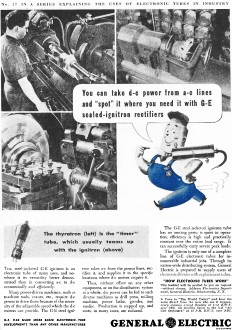|
"Ignitron" sounds like a contemporary
pejorative term for someone who blindly follows orders. In the 1940s, though, it
was a type of steel-jacketed vacuum tube manufactured by General Electric for use
in conversion from alternating alternating to direct current (AC-DC) power supplies.
According to this GE document, "Ignitrons
are gas-discharge, pool-type cathode tubes in which the arc is started for each
conducting cycle by means of a starting or ignition electrode. The tubes are of
the half-wave type in which the current is carried through the tube during only
the positive part of the cycle. During the remainder or non-conducting part the
residual ionization reaches very low values in comparison with the ionization present
in the multi-anode type of pool tube where it is proportional to the load current
carried. As a result of the so-called dark, negative half-cycle, the shielding required
in half-wave tubes is greatly reduced from that in the multi-anode tube. Reduction
in shielding in turn lowers the arc voltages so that tubes of this type may be efficiently
applied in the lower voltage (125 to 250 volt) fields. Mercury-pool cathodes are
capable of supplying emission currents of may thousands of amperes..." Thus, in
that last sentence we know why Ignitrons are no longer used (other than the fact
that semiconductors are available to do the job) - the mercury in them would rate
them a hazardous device status and therefore be taboo in modern paranoid society
in which mercury but "mostly peaceful" riots (er -protests) are considered unacceptably
dangerous to public health.
No. 17 In a Series Explaining the Uses of Electronic Tubes in Industry
 You can take d-c power from a-c lines and
"spot" it where you need it with G-E sealed-ignition rectifiers You can take d-c power from a-c lines and
"spot" it where you need it with G-E sealed-ignition rectifiers
Thy thyratron (left) is the "timer" tube, which usually teams up with the ignitron
(above).
The steel-jacketed G-E ignitron is an electronic tube of many uses, and nowhere
is its versatility better demonstrated than in converting a-c to d-c economically
and efficiently.
Many power-driven machines, such as machine tools, cranes, etc., require d-c
power to drive them because of the necessity of the adjustable speed which the d-c
motors can provide. The G-E steel ignitron takes a-c from the power lines, rectifies
it, and supplies it to the specific locations where d-c motors require it.
Thus, without effect on any other equipment, or on the distribution system as
a whole, d-c power can be fed to such diverse machines as drill press, milling machine,
power lathe, grinder, and sander. Production is stepped up, and costs, in many cases,
are reduced.
The G-E steel-jacketed ignitron tube has no moving parts; is quiet in operation;
efficiency is high and practically constant over the entire load range. It can successfully
carry severe peak loads.
The ignitron is only one of a complete line of G-E electronic tubes for innumerable
industrial jobs. Through its nationwide distributing system, General Electric is
prepared to supply users of electronic devices with replacement tubes.
"How Electronic Tubes Work"
This booklet will be mailed to you on request - without charge. Address Electronics
Department, General Electric, Schenectady, N. Y.
• Tune in "The World Today" and hear the news direct from the men who see
it happen, every evening except Sunday at 6:45 E.W.T. over CBS. On Sunday listen
to the G-E "All Girl Orchestra" at 10 P.M. E.W.T. over NBC.
G.E. Has Made More Basic Electronic-Tube Developments Than Any Other Manufacturer
General Electric
162-C10-8850
Posted April 6, 2021
|










